Honor Award
Slip District: Chicago's Testing Ground for Water Industry
Nina Chase, Assoc. ASLA, Graduate, Harvard Graduate School of Design
Faculty Advisor: Philip Enquist ASLA, FAIA
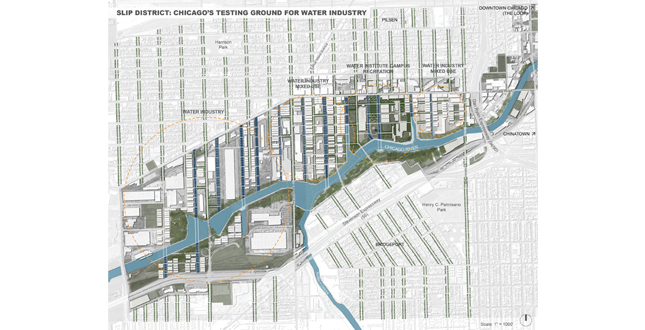 Close Me!
Close Me!Slip District: Chicago’s Testing Ground for Water Industry.
Download Hi-Res ImageImage: Nina Chase
Image 1 of 13
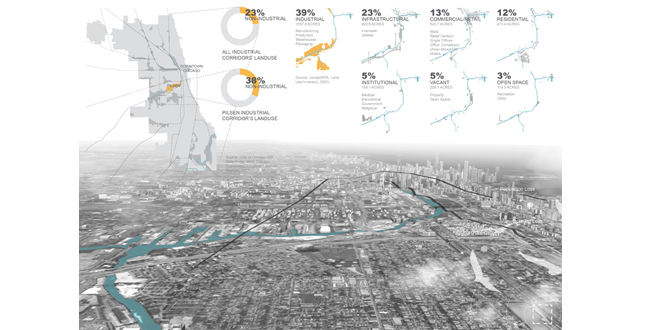 Close Me!
Close Me!Chicago: Underutilized Industrial Corridors. The Chicago River is currently underappreciated and environmentally mismanaged within a landscape of underutilized industrial corridors. However with the decline of traditional heavy industries, the shrinkage provides the opportunity to responsibly insert a new, sustainable industry along the Chicago River.
Download Hi-Res ImageImage: Nina Chase
Image 2 of 13
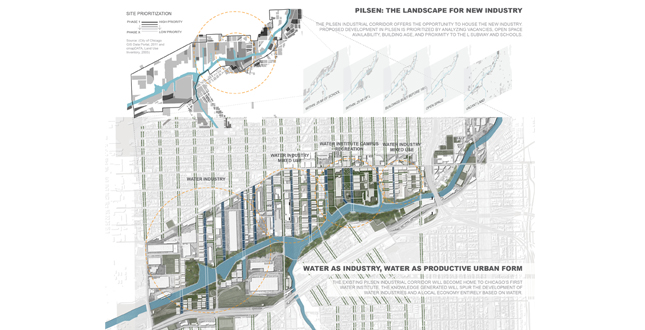 Close Me!
Close Me!Pilsen: The landscape for new industry. The Pilsen Industrial Corridor offers the opportunity to house the new industry. Proposed development in Pilsen is prioritized by analyzing vacancies, open space availability, building age, and proximity to the L subway and schools. The existing Pilsen Industrial Corridor will become home to Chicago’s first Water Institute. The knowledge generated will spur the development of water industries and a local economy entirely based on water.
Download Hi-Res ImageImage: Nina Chase
Image 3 of 13
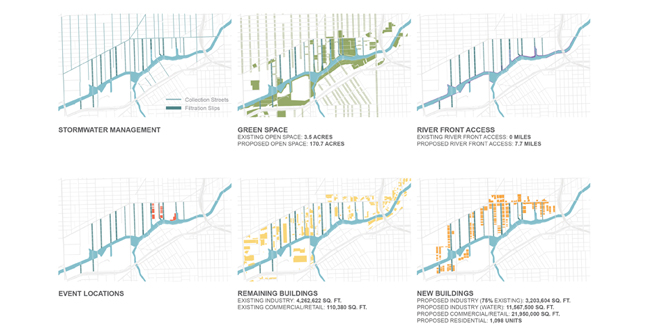 Close Me!
Close Me!Functioning Systems. Innovative stormwater management, increased open space, and riverfront access set the stage for appropriate, sustainable development.
Download Hi-Res ImageImage: Nina Chase
Image 4 of 13
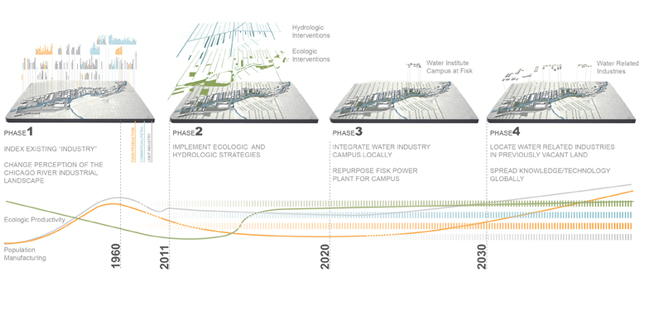 Close Me!
Close Me!Phasing: Changing Perceptions, Making Room for Water, Educating a City, and Generating an Economy. The Slip District masterplan operates as a compilation of 4 distinct phases.
Download Hi-Res ImageImage: Nina Chase
Image 5 of 13
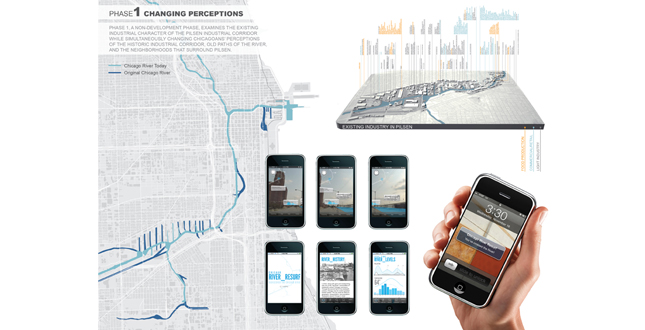 Close Me!
Close Me!Phase 1: Changing Perceptions. Phase 1, a non-development phase, examines the existing industrial character of the Pilsen Industrial Corridor while simultaneously changing Chicagoans’ perceptions of the historic industrial corridor, old paths of the river, and the neighborhoods that surround Pilsen.
Download Hi-Res ImageImage: Nina Chase
Image 6 of 13
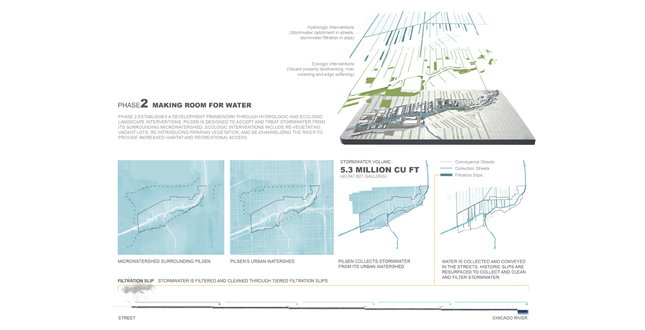 Close Me!
Close Me!Phase 2: Making Room for Water. Phase 2 establishes a development framework through hydrologic and ecologic landscape interventions. Pilsen is designed to accept and treat stormwater from its surrounding microwatershed. Ecologic interventions include re-vegetating vacant lots, re-introducing riparian vegetation, and de-channelizing the river to provide increased habitat and recreational access.
Download Hi-Res ImageImage: Nina Chase
Image 7 of 13
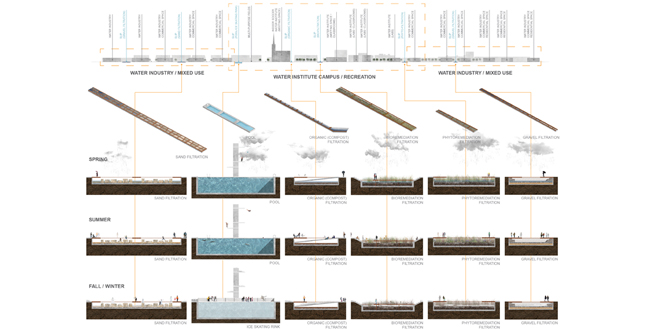 Close Me!
Close Me!Phase 2: Experimental Filtration and Seasonal Programming. In keeping with the research and experimentation promoted by the Water Institute, the filtering slips become unique urban demonstrations of water filtration technologies. Pilsen is transformed into a testing ground for the effectiveness of varying filtration systems.
Download Hi-Res ImageImage: Nina Chase
Image 8 of 13
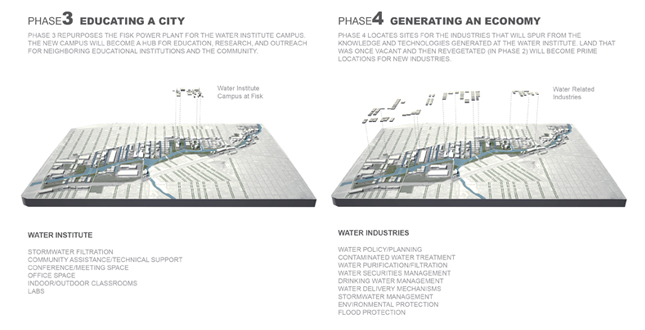 Close Me!
Close Me!Phase 3: Educating a City. Phase 3 Repurposes the Fisk Power Plant for the Water Institute Campus. The new campus will become a hub for education, research, and outreach for neighboring educational institutions and the community. Phase 4: Generating an Economy. Phase 4 locates sites for the industries that will spur from the knowledge and technologies generated at the Water Institute. Land that was once vacant and then revegetated (in Phase 2) will become prime locations for new industries.
Download Hi-Res ImageImage: Nina Chase
Image 9 of 13
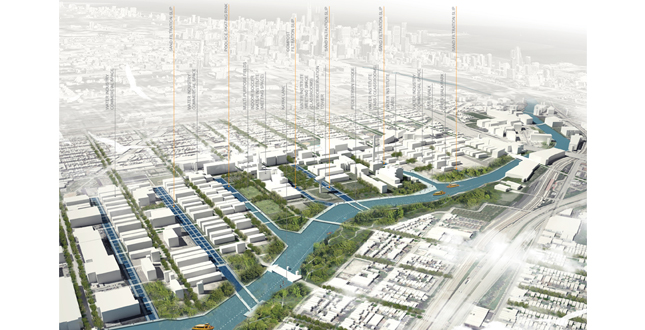 Close Me!
Close Me!Slip District: Celebrating Water Industry and Urban Hydrology. With the reinvention of the Pilsen Industrial Corridor, Chicago will highlight its hydrologic resources and once again be connected globally through an industry along its river.
Download Hi-Res ImageImage: Nina Chase
Image 10 of 13
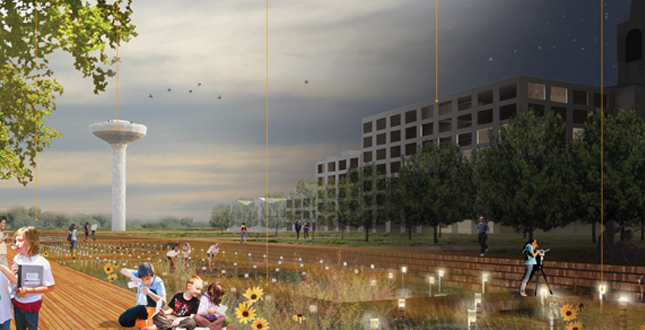 Close Me!
Close Me!Interaction Encouraged, Day and Night. The biofiltration slip engages the community day and night. Located in the heart of the district, this slip allows for increased public engagement. The new water tower also functions to store water and provides incredible views of the Chicago city skyline.
Download Hi-Res ImageImage: Nina Chase
Image 11 of 13
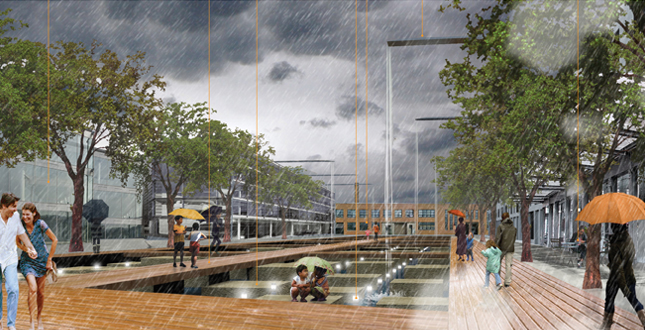 Close Me!
Close Me!Stormwater Visibly Celebrated. The sandfiltration slip captures stormwater from the street and rooftop runnels. Wooden walks and sandstone blocks allow for interaction while indicator lights change color as water progressively cleans, allowing the public to visually recognize the experimental nature of the slip.
Download Hi-Res ImageImage: Nina Chase
Image 12 of 13
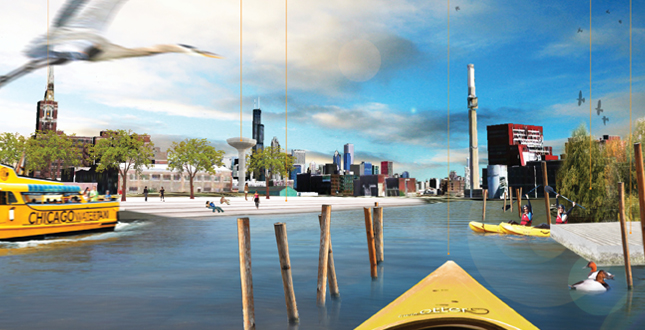 Close Me!
Close Me!The Chicago River Reactivated. Culturally and ecologically activated, the new edge condition along the Chicago River includes a riverwalk, a kayak lane for protected recreation, a healthy riparian buffer, and restored aquatic and avian habitats.
Download Hi-Res ImageImage: Nina Chase
Image 13 of 13
Project Statement
Vacant land, dying industry, and a declining manufacturing sector warrant a rethinking of the role of industrial corridors along the Chicago River. Although traditional industrial corridors are shrinking, the vacancies provide the opportunity to insert a new sustainable industry into the Chicago River landscape. Chicago’s Slip District emerges as an economic and ecological response. By coupling localized water based industries with a performative hydrologic landscape, Chicago will once again be connected globally through an industry along its river.
Project Narrative
Context (Chicago’s Underappreciated River and Underutilized Industrial Corridors)
The Chicago River has a storied history directly related to the development of one of America’s great post-industrial cities. First used as a trade route when Chicago was explored in the late 17th century, the River continued to play an important economic role through the city’s industrial boom. Dredged, channelized, and even reversed, the Chicago River was heavily engineered to serve as a highway for ships and barges headed to the Mississippi River. Industrial corridors were located close to the river to take advantage of the ease of transportation and waste removal.
The city infamously reversed the flow of the Chicago River to save its drinking water source, Lake Michigan, from pollution, but in doing so managed to send its waste downstream to the Gulf of Mexico.More recently, the city has been constructing its TARP system, storing stormwater and waste water in underground reservoirs and massive pipes until the water can be treated. But even with these feats of engineering, Chicago’s combined sewer overflow (CSO) system still dumps untreated effluent directly into the River on a regular basis.
The Chicago River is currently underappreciated and environmentally mismanaged within a landscape of underutilized industrial corridors. As a powerful industrial city, once bustling with lumber mills and meat packing facilities, Chicago allocated ample space for its industrial landscapes. Today, however, these industrial corridors are underutilized. Although designated as official industrial corridors, almost a quarter of this land is not used for traditional industrial purposes. The Pilsen Industrial Corridor, located along the South Branch of the Chicago River, within 2 miles of Chicago’s downtown Loop, is even less utilized for industry, with close to 40% of its land being used for other purposes: residences, commerce, institutional development.
As technologies, economies, and ecologies shift within the city, the changes should be reflected in the urban fabric. New, sustainable industries should be environmentally and culturally melded with new development. With the traditional heavy industries declining along the Chicago River, the shrinkage provides the opportunity to responsibly insert a new industry into the River landscape.
Concept (Water as Industry, Water as Productive Urban Form)
What if the new industry could relate directly to the Chicago River? What if Chicago’s new industry was WATER itself? The city, situated on one of the largest fresh water bodies in the world, Lake Michigan, will redefine itself as the idea generator and production hub for sustainable freshwater resource management. The existing Pilsen Industrial Corridor will become Chicago’s
Slip Distict, home to Chicago’s first Water Institute. The Institute will be devoted to research, training, and technological developments related to water filtration, community awareness, and water policy and planning. The knowledge generated will spur the development of water industries, creating needed jobs and a local economy entirely based on water.
In addition, the landscape of Pilsen will become a performative hydrologic infrastructure in and of itself. The 14 historic industrial slips that once allowed barge access into the Pilsen Industrial Corridor will be unearthed and used to collect and treat stormwater in experimental water filtration slips.
Site Location (Pilsen: The Landscape for New Industry)
With a strong industrial history, current vacancies, and prime location along the River, the Pilsen Industrial Corridor offers an incredible opportunity to house the new Water Institute and subsequent water industries. The Water Institute repurposes the Fisk Power Plant, which is scheduled to close in 2015, by maintaining buildings for research labs, classrooms, and community meeting space. Mixed-use development along West Cermack Road and within the district provides space for commerce, residences, and future water industries. The river is widened and its edge is softened, increasing recreational opportunities and ecological habitats.
Phasing (Changing Perceptions, Making Room for Water, Celebrating Urban Hydrology)
The Slip District masterplan operates as a compilation of 4 distinct phases. Phase 1 is a non-development phase which examines the existing industrial character of the Pilsen Industrial Corridor.Phase 1 also simultaneously changes Chicagoans’ perceptions of the historic industrial corridor, the past routes of the River, and the neighborhoods that surround Pilsen. Using digital location based technology in the form of a smart phone application, Phase 1 incorporates a promotional/marketing push to re-introduce the community to the River.With minimal funding and no construction, Phase 1 can immediately change the perception of Pilsen’s post-industrial landscape while generating interest for future change.
Phase 2 establishes a development framework through hydrologic and ecologic landscape interventions. With stormwater management as its core function, Pilsen is designed to accept and treat the stormwater from its surrounding microwatershed. Responsible for treating 5.3 million cubic feet of stormwater, streets are transformed to capture and convey stormwater into filtration slips. In keeping with the research and experimentation promoted by the Water Institute, the filtering slips become unique urban demonstrations of water filtration technologies.Pilsen is transformed into a testing ground for the effectiveness of varying types of filtration systems. Each of the filtering slips employs a unique filtering technology to clean stormwater. Five strategies of filtration (sand filtration, organic/compost filtration, gravel filtration, bioremediation filtration, and phytoremediation filtration) are applied. Cleanliness of water and pollution levels are displayed through interactive, real-time indicator lights that serve to notify the Water Institute of changes and to engage the public. In addition to the hydrologic strategy of Phase 1, proposed ecologic interventions include re-vegetating vacant lots, reintroducing riparian vegetation, and de-channelizing the river to provide increased habitat and recreational access.
Phase 2 strategies prepare and set the stage for Phase 3, which includes repurposing the Fisk Power Plant for the Water Institute Campus. The new campus will become a hub for education, research, and outreach for neighboring educational institutions and the community.The campus incorporates space for indoor and outdoor classrooms, labs, research facilities, conference space, and meeting rooms. Additionally, Phase 2 introduces recreation along the river by transforming one of the slips into a pool in the Summer and a skating rink in the Winter, providing kayak launch points, delineating a kayak lane along the south side of the River, and constructing multi-use sport fields.
Phase 4 identifies sites for industries that are byproducts of the knowledge and technologies generated at the Water Institute. Land that was once vacant and then revegetated (in Phase 2) will become prime locations for these new industries and satellite Water Institute offices. The demand for the knowledge, skills, products, and jobs created will be universal. With the reinvention of the Pilsen Industrial Corridor, Chicago will highlight its hydrologic resources and once again be connected globally through an industry along its river.
Additional Project Credits
Fellow Harvard GSD Chicago Waterline Studiomates
SOM Chicago Urban Planning Group
Friends of the Chicago River
City of Chicago: Chicago Sustainable Industries





